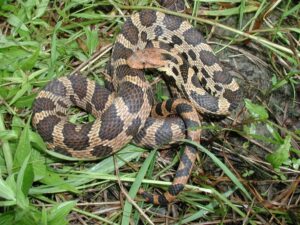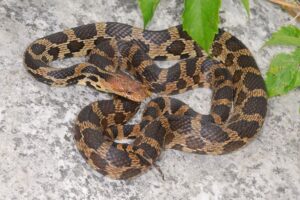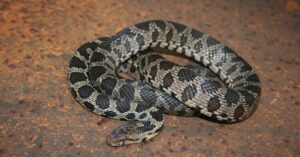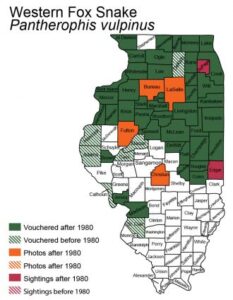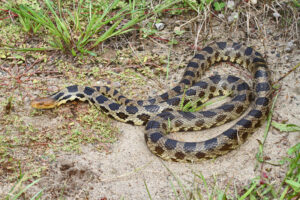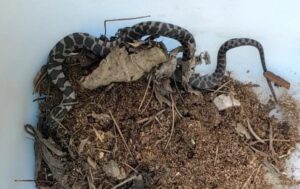The eastern fox snake or eastern foxsnake is a species of rat snake in the Colubridae family. It is endemic to the eastern Great Lakes region of the US and adjacent western Ontario in Canada. The excellent climbers can often be found foraging in trees and shrubs.
Between 1990 and 2011, foxsnakes were divided into two species, P. gloydi, or eastern foxsnakes, and P. vulpinus, or western foxsnakes. A 2011 paper by Crother, Eckstut, White, Graham, Savage, and Gardner proposed that the Mississippi river be considered the boundary for dividing foxsnakes. So, the fox snakes to its east came to be known as P. vulpinus (including the ones previously known as P. gloydi) and those to the west were given a new name, P. ramspotti. The specific name, gloydi, is in recognition of the American herpetologist Howard K. Gloyd.
Scientific Classifications
- Suborder:Serpentes
- Family:Colubridae
- Genus:Pantherophis
- Species:P. vulpinus
Conservation Status
Description
Size
The adults are moderately large, with a length of around 3-5.5 ft (0.9-1.7 m).
Color and Appearance
The boldly patterned snake has big black or dark brown blotches along the middle of its back and smaller, alternating blotches along the sides of the yellowish to light brown body. The yellowish-checkered belly has dark squarish spots. The head can be light brown to reddish brown or yellow and is generally unmarked except for a few dark bands extending from the eye to the mouth and a dark band on top of the head between the eyes.
The babies are paler than the adults in color and have brown or gray blotches bordered in black on the back. They have more prominent head patterns.
Are They Dangerous to Humans
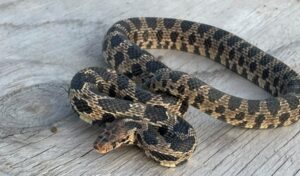
The eastern fox snake occasionally wiggles its tail, rustling leaves to mimic the sound of rattlesnakes in order to drive away its attacker. When threatened, it can also coil and if it continues feeling insecure, it strikes.
Eastern Fox Snakes at a Glance
Distribution
It can be found in the states of Michigan and Ohio in the US and Western Ontario, Canada.
Habitat
The eastern fox snake lives in wetlands such as marshes and adjacent meadows and fields.
The species is considered endangered due to habitat loss. Its dwindling numbers can be attributed to the development of coastal habitats and wetlands and collection for the pet trade. Its mimicry of rattlesnakes makes people fear that it is venomous and contributes to its declining numbers.
Lifespan
Eastern foxsnakes can live for near about 20 years.
Predators
It falls prey to coyotes, foxes, and hawks.
Diet
The powerful constrictor eats various birds and small mammals.
Reproduction
Oviparous (lays eggs that hatch outside the body)
After sexual reproduction, the snake can lay 7-29 eggs in decaying wood, humus, or under logs. They generally hatch after 60 days.
Source
atlas.ohparc.org, i.pinimg.com, iowaherps.com, scontent.fccu4-2.fna.fbcdn.net, herpetology.inhs.illinois.edu, inaturalist.ca, reddit.com

